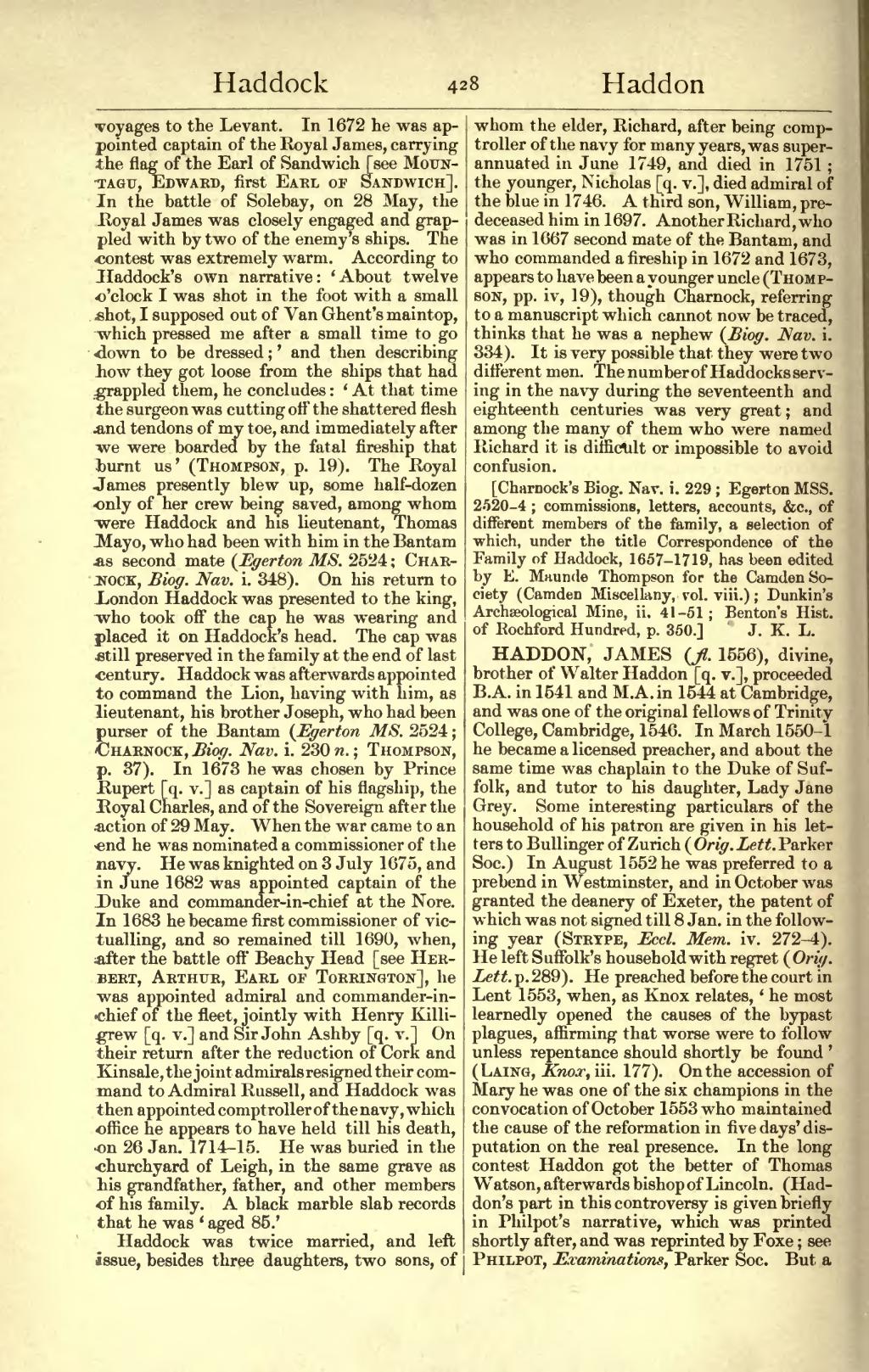voyages to the Levant. In 1672 he was appointed captain of the Royal James, carrying the flag of the Earl of Sandwich [see Mountagu, Edward, first Earl of Sandwich]. In the battle of Solebay, on 28 May, the Royal James was closely engaged and grappled with by two of the enemy's ships. The contest was extremely warm. According to Haddock's own narrative: 'About twelve o'clock I was shot in the foot with a small shot, I supposed out of Van Ghent's maintop, which pressed me after a small time to go down to be dressed ;' and then describing how they got loose from the ships that had grappled them, he concludes: 'At that time the surgeon was cutting off the shattered flesh and tendons of my toe, and immediately after we were boarded by the fatal fireship that burnt us' (Thompson, p. 19). The Royal James presently blew up, some half-dozen only of her crew being saved, among whom were Haddock and his lieutenant, Thomas Mayo, who had been with him in the Bantam as second mate (Egerton MS. 2524; Charlock, Biog. Nav. i. 348). On his return to London Haddock was presented to the king, who took off the cap he was wearing and placed it on Haddock's head. The cap was still preserved in the family at the end of last century. Haddock was afterwards appointed to command the Lion, having with him, as lieutenant, his brother Joseph, who had been purser of the Bantam (Egerton MS. 2524; Charnock, Biog. Nav. i. 230n.; Thompson, p. 37). In 1673 he was chosen by Prince Rupert [q. v.] as captain of his flagship, the Royal Charles, and of the Sovereign after the Action of 29 May. When the war came to an end he was nominated a commissioner of the navy. He was knighted on 3 July 1675, and in June 1682 was appointed captain of the Duke and commander-in-chief at the Nore. In 1683 he became first commissioner of victualling, and so remained till 1690, when, After the battle off Beachy Head [see Herbert, Arthur, Earl of Torrington], he was appointed admiral and commander-in-chief of the fleet, jointly with Henry Killigrew [q. v.] and Sir John Ashby [q. v.] On their return after the reduction of Cork and Kinsale, the joint admirals resigned their command to Admiral Russell, and Haddock was then appointed comptroller of the navy, which office he appears to have held till his death, on 26 Jan. 1714-15. He was buried in the churchyard of Leigh, in the same grave as his grandfather, father, and other members of his family. A black marble slab records that he was 'aged 85.'
Haddock was twice married, and left issue, besides three daughters, two sons, of whom the elder, Richard, after being comptroller of the navy for many years, was super-annuated in June 1749, and died in 1751 ; the younger, Nicholas [q. v.], died admiral of the blue in 1746. A third son, William, pre-deceased him in 1697. Another Richard, who was in 1667 second mate of the Bantam, and who commanded a fireship in 1672 and 1673, appears to have been a younger uncle (Thompson, pp. iv, 19), though Charnock, referring to a manuscript which cannot now be traced, thinks that he was a nephew (Biog. Nav. i. 334). It is very possible that they were two different men. The number of Haddocks serving in the navy during the seventeenth and eighteenth centuries was very great; and among the many of them who were named Richard it is difficult or impossible to avoid confusion.
[Charnock's Biog. Nav. i. 229 ; Egerton MSS. 2520-4 ; commissions, letters, accounts, &c., of different members of the family, a selection of which, under the title Correspondence of the Family of Haddock, 1657-1719, has been edited by E. Maunde Thompson for the Camden Society (Camden Miscellany, vol. viii.); Dunkin's Archæological Mine, ii, 41-51 ; Benton's Hist. of Rochford Hundred, p. 350.]
HADDON, JAMES (fl. 1556), divine, brother of Walter Haddon [q. v.], proceeded B.A. in 1541 and M.A. in 1544 at Cambridge, and was one of the original fellows of Trinity College, Cambridge, 1546. In March 1550-1 he became a licensed preacher, and about the same time was chaplain to the Duke of Suffolk, and tutor to his daughter, Lady Jane Grey. Some interesting particulars of the household of his patron are given in his letters to Bullinger of Zurich (Orig. Lett. Parker Soc.) In August 1552 he was preferred to a prebend in Westminster, and in October was granted the deanery of Exeter, the patent of which was not signed till 8 Jan. in the following year Strype, Eccl. Mem. iv. 272-4). He left Suffolk's household with regret (Orig. Lett. p. 289). He preached before the court in Lent 1553, when, as Knox relates, 'he most learnedly opened the causes of the bypast plagues, affirming that worse were to follow unless repentance should shortly be found' (Laing, Knox, iii. 177). On the accession of Mary he was one of the six champions in the convocation of October 1553 who maintained the cause of the reformation in five days' disputation on the real presence. In the long contest Haddon got the better of Thomas Watson, afterwards bishop of Lincoln. (Haddon's part in this controversy is given briefly in Philpot's narrative, which was printed shortly after, and was reprinted by Foxe ; see Philpot, Examinations, Parker Soc. But a

